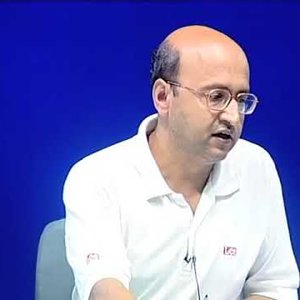You are using an out of date browser. It may not display this or other websites correctly.
You should upgrade or use an alternative browser.
You should upgrade or use an alternative browser.
What is Big bang: Definition and 914 Discussions
The Big Bang theory is the prevailing cosmological model explaining the existence of the observable universe from the earliest known periods through its subsequent large-scale evolution. The model describes how the universe expanded from an initial state of high density and temperature, and offers a comprehensive explanation for a broad range of observed phenomena, including the abundance of light elements, the cosmic microwave background (CMB) radiation, and large-scale structure.
Crucially, the theory is compatible with Hubble–Lemaître law — the observation that the farther away galaxies are, the faster they are moving away from Earth. Extrapolating this cosmic expansion backwards in time using the known laws of physics, the theory describes an increasingly concentrated cosmos preceded by a singularity in which space and time lose meaning (typically named "the Big Bang singularity"). Detailed measurements of the expansion rate of the universe place the Big Bang singularity at around 13.8 billion years ago, which is thus considered the age of the universe.After its initial expansion, an event that is by itself often called "the Big Bang", the universe cooled sufficiently to allow the formation of subatomic particles, and later atoms. Giant clouds of these primordial elements – mostly hydrogen, with some helium and lithium – later coalesced through gravity, forming early stars and galaxies, the descendants of which are visible today. Besides these primordial building materials, astronomers observe the gravitational effects of an unknown dark matter surrounding galaxies. Most of the gravitational potential in the universe seems to be in this form, and the Big Bang theory and various observations indicate that this excess gravitational potential is not created by baryonic matter, such as normal atoms. Measurements of the redshifts of supernovae indicate that the expansion of the universe is accelerating, an observation attributed to dark energy's existence.Georges Lemaître first noted in 1927 that an expanding universe could be traced back in time to an originating single point, which he called the "primeval atom". Edwin Hubble confirmed through analysis of galactic redshifts in 1929 that galaxies are indeed drifting apart; this is important observational evidence for an expanding universe. For several decades, the scientific community was divided between supporters of the Big Bang and the rival steady-state model which both offered explanations for the observed expansion, but the steady-state model stipulated an eternal universe in contrast to the Big Bang's finite age. In 1964, the CMB was discovered, which convinced many cosmologists that the steady-state theory was falsified, since, unlike the steady-state theory, the hot Big Bang predicted a uniform background radiation throughout the universe caused by the high temperatures and densities in the distant past. A wide range of empirical evidence strongly favors the Big Bang, which is now essentially universally accepted.
View More On Wikipedia.org
Crucially, the theory is compatible with Hubble–Lemaître law — the observation that the farther away galaxies are, the faster they are moving away from Earth. Extrapolating this cosmic expansion backwards in time using the known laws of physics, the theory describes an increasingly concentrated cosmos preceded by a singularity in which space and time lose meaning (typically named "the Big Bang singularity"). Detailed measurements of the expansion rate of the universe place the Big Bang singularity at around 13.8 billion years ago, which is thus considered the age of the universe.After its initial expansion, an event that is by itself often called "the Big Bang", the universe cooled sufficiently to allow the formation of subatomic particles, and later atoms. Giant clouds of these primordial elements – mostly hydrogen, with some helium and lithium – later coalesced through gravity, forming early stars and galaxies, the descendants of which are visible today. Besides these primordial building materials, astronomers observe the gravitational effects of an unknown dark matter surrounding galaxies. Most of the gravitational potential in the universe seems to be in this form, and the Big Bang theory and various observations indicate that this excess gravitational potential is not created by baryonic matter, such as normal atoms. Measurements of the redshifts of supernovae indicate that the expansion of the universe is accelerating, an observation attributed to dark energy's existence.Georges Lemaître first noted in 1927 that an expanding universe could be traced back in time to an originating single point, which he called the "primeval atom". Edwin Hubble confirmed through analysis of galactic redshifts in 1929 that galaxies are indeed drifting apart; this is important observational evidence for an expanding universe. For several decades, the scientific community was divided between supporters of the Big Bang and the rival steady-state model which both offered explanations for the observed expansion, but the steady-state model stipulated an eternal universe in contrast to the Big Bang's finite age. In 1964, the CMB was discovered, which convinced many cosmologists that the steady-state theory was falsified, since, unlike the steady-state theory, the hot Big Bang predicted a uniform background radiation throughout the universe caused by the high temperatures and densities in the distant past. A wide range of empirical evidence strongly favors the Big Bang, which is now essentially universally accepted.
View More On Wikipedia.org
-

Question about the Big Bang and CMB
This may seem like a naive or obvious question, which is why I posted it here. How do we know the cosmic microwave background came from the Big Bang? How can we tell how old radiation is?- BadgerBadger92
- Thread
- Replies: 3
- Forum: Introductory Physics Homework Help
-
R
I Big Bang Singularity: Was It As "Infinitely Dense" As We Think?
The big bang supposedly originated from an infinitely dense singularity of space/time. The concept of infinitely dense is an artifact from our current perception of how immense our universe is today and how spread-out space/time is. However, if I were present in the reference frame of that...- Ratman101
- Thread
-
- Tags
- Big bang Singularity
- Replies: 35
- Forum: Cosmology
-

Astrophysics & Cosmology by Prof. S. Bharadwaj (NPTEL):- Lecture 1: Introduction
Copyright reserved to Prof. Bharadwaj and NPTEL, Govt. of India. Lectures: http://www.nptel.ac.in/courses/115105046/ Syllabus: http://www.nptel.ac.in/syllabus/syllabus.php?subjectId=115105046- Wrichik Basu
- Media item
- astronomy big bang cosmolgy
- Comments: 0
- Category: Astronomy and Cosmology
-

Astrophysics & Cosmology by Prof. S. Bharadwaj (NPTEL):- Lecture 2: Kepler's Law
Copyright reserved to Prof. Bharadwaj and NPTEL, Govt. of India. Lectures: http://www.nptel.ac.in/courses/115105046/ Syllabus: http://www.nptel.ac.in/syllabus/syllabus.php?subjectId=115105046- Wrichik Basu
- Media item
- astronomy big bang cosmolgy
- Comments: 0
- Category: Astronomy and Cosmology
-

Astrophysics & Cosmology by Prof. S. Bharadwaj (NPTEL):- Lecture 3: The Solar System
Copyright reserved to Prof. Bharadwaj and NPTEL, Govt. of India. Lectures: http://www.nptel.ac.in/courses/115105046/ Syllabus: http://www.nptel.ac.in/syllabus/syllabus.php?subjectId=115105046- Wrichik Basu
- Media item
- astronomy big bang cosmolgy
- Comments: 0
- Category: Astronomy and Cosmology
-

Astrophysics & Cosmology by Prof. S. Bharadwaj (NPTEL):- Lecture 4: The Solar System (Contd.)
Copyright reserved to Prof. Bharadwaj and NPTEL, Govt. of India. Lectures: http://www.nptel.ac.in/courses/115105046/ Syllabus: http://www.nptel.ac.in/syllabus/syllabus.php?subjectId=115105046- Wrichik Basu
- Media item
- astronomy big bang cosmolgy
- Comments: 0
- Category: Astronomy and Cosmology
-

Astrophysics & Cosmology by Prof. S. Bharadwaj (NPTEL):- Lecture 5: Binary Systems
Copyright reserved to Prof. Bharadwaj and NPTEL, Govt. of India. Lectures: http://www.nptel.ac.in/courses/115105046/ Syllabus: http://www.nptel.ac.in/syllabus/syllabus.php?subjectId=115105046- Wrichik Basu
- Media item
- astronomy big bang cosmolgy
- Comments: 0
- Category: Astronomy and Cosmology
-

Astrophysics & Cosmology by Prof. S. Bharadwaj (NPTEL):- Lecture 6: Binary Systems (Contd.)
Copyright reserved to Prof. Bharadwaj and NPTEL, Govt. of India. Lectures: http://www.nptel.ac.in/courses/115105046/ Syllabus: http://www.nptel.ac.in/syllabus/syllabus.php?subjectId=115105046- Wrichik Basu
- Media item
- astronomy big bang cosmolgy
- Comments: 0
- Category: Astronomy and Cosmology
-

Astrophysics & Cosmology by Prof. S. Bharadwaj (NPTEL):- Lecture 7: Tidal Forces and the Earth Moon System
Copyright reserved to Prof. Bharadwaj and NPTEL, Govt. of India. Lectures: http://www.nptel.ac.in/courses/115105046/ Syllabus: http://www.nptel.ac.in/syllabus/syllabus.php?subjectId=115105046- Wrichik Basu
- Media item
- astronomy big bang cosmolgy
- Comments: 0
- Category: Astronomy and Cosmology
-

Astrophysics & Cosmology by Prof. S. Bharadwaj (NPTEL):- Lecture 8: Fluid Mechanics
Copyright reserved to Prof. Bharadwaj and NPTEL, Govt. of India. Lectures: http://www.nptel.ac.in/courses/115105046/ Syllabus: http://www.nptel.ac.in/syllabus/syllabus.php?subjectId=115105046- Wrichik Basu
- Media item
- astronomy big bang cosmolgy
- Comments: 0
- Category: Astronomy and Cosmology
-

Astrophysics & Cosmology by Prof. S. Bharadwaj (NPTEL):- Lecture 9: Hydrostatics and the Solar Wind
Copyright reserved to Prof. Bharadwaj and NPTEL, Govt. of India. Lectures: http://www.nptel.ac.in/courses/115105046/ Syllabus: http://www.nptel.ac.in/syllabus/syllabus.php?subjectId=115105046- Wrichik Basu
- Media item
- astronomy big bang cosmolgy
- Comments: 0
- Category: Astronomy and Cosmology
-

Astrophysics & Cosmology by Prof. S. Bharadwaj (NPTEL):- Lecture 10: Radiative Transfer
Copyright reserved to Prof. Bharadwaj and NPTEL, Govt. of India. Lectures: http://www.nptel.ac.in/courses/115105046/ Syllabus: http://www.nptel.ac.in/syllabus/syllabus.php?subjectId=115105046- Wrichik Basu
- Media item
- astronomy big bang cosmolgy
- Comments: 0
- Category: Astronomy and Cosmology
-

Astrophysics & Cosmology by Prof. S. Bharadwaj (NPTEL):- Lecture 11: Radiative Transfer (Contd.)
Copyright reserved to Prof. Bharadwaj and NPTEL, Govt. of India. Lectures: http://www.nptel.ac.in/courses/115105046/ Syllabus: http://www.nptel.ac.in/syllabus/syllabus.php?subjectId=115105046- Wrichik Basu
- Media item
- astronomy big bang cosmolgy
- Comments: 0
- Category: Astronomy and Cosmology
-

Astrophysics & Cosmology by Prof. S. Bharadwaj (NPTEL):- Lecture 12: Thermal Radiation
Copyright reserved to Prof. Bharadwaj and NPTEL, Govt. of India. Lectures: http://www.nptel.ac.in/courses/115105046/ Syllabus: http://www.nptel.ac.in/syllabus/syllabus.php?subjectId=115105046- Wrichik Basu
- Media item
- astronomy big bang cosmolgy
- Comments: 0
- Category: Astronomy and Cosmology
-

Astrophysics & Cosmology by Prof. S. Bharadwaj (NPTEL):- Lecture 13: Thermal Radiation and the Sun
Copyright reserved to Prof. Bharadwaj and NPTEL, Govt. of India. Lectures: http://www.nptel.ac.in/courses/115105046/ Syllabus: http://www.nptel.ac.in/syllabus/syllabus.php?subjectId=115105046- Wrichik Basu
- Media item
- astronomy big bang cosmolgy
- Comments: 0
- Category: Astronomy and Cosmology
-

Astrophysics & Cosmology by Prof. S. Bharadwaj (NPTEL):- Lecture 14: Virial Theorem and Its Application to Stars
Copyright reserved to Prof. Bharadwaj and NPTEL, Govt. of India. Lectures: http://www.nptel.ac.in/courses/115105046/ Syllabus: http://www.nptel.ac.in/syllabus/syllabus.php?subjectId=115105046- Wrichik Basu
- Media item
- astronomy big bang cosmolgy
- Comments: 0
- Category: Astronomy and Cosmology
-

Astrophysics & Cosmology by Prof. S. Bharadwaj (NPTEL):- Lecture 15: Stars: Magnitudes and the H-R Diagram
Copyright reserved to Prof. Bharadwaj and NPTEL, Govt. of India. Lectures: http://www.nptel.ac.in/courses/115105046/ Syllabus: http://www.nptel.ac.in/syllabus/syllabus.php?subjectId=115105046- Wrichik Basu
- Media item
- astronomy big bang cosmolgy
- Comments: 0
- Category: Astronomy and Cosmology
-

Astrophysics & Cosmology by Prof. S. Bharadwaj (NPTEL):- Lecture 16: Stellar Physics - I
Copyright reserved to Prof. Bharadwaj and NPTEL, Govt. of India. Lectures: http://www.nptel.ac.in/courses/115105046/ Syllabus: http://www.nptel.ac.in/syllabus/syllabus.php?subjectId=115105046- Wrichik Basu
- Media item
- astronomy big bang cosmolgy
- Comments: 0
- Category: Astronomy and Cosmology
-

Astrophysics & Cosmology by Prof. S. Bharadwaj (NPTEL):- Lecture 17: Stellar Physics - II
Copyright reserved to Prof. Bharadwaj and NPTEL, Govt. of India. Lectures: http://www.nptel.ac.in/courses/115105046/ Syllabus: http://www.nptel.ac.in/syllabus/syllabus.php?subjectId=115105046- Wrichik Basu
- Media item
- astronomy big bang cosmolgy
- Comments: 0
- Category: Astronomy and Cosmology
-

Astrophysics & Cosmology by Prof. S. Bharadwaj (NPTEL):- Lecture 18: Stellar Physics - III
Copyright reserved to Prof. Bharadwaj and NPTEL, Govt. of India. Lectures: http://www.nptel.ac.in/courses/115105046/ Syllabus: http://www.nptel.ac.in/syllabus/syllabus.php?subjectId=115105046- Wrichik Basu
- Media item
- astronomy big bang cosmolgy
- Comments: 0
- Category: Astronomy and Cosmology
-

Astrophysics & Cosmology by Prof. S. Bharadwaj (NPTEL):- Lecture 19: Stellar Physics - IV
Copyright reserved to Prof. Bharadwaj and NPTEL, Govt. of India. Lectures: http://www.nptel.ac.in/courses/115105046/ Syllabus: http://www.nptel.ac.in/syllabus/syllabus.php?subjectId=115105046- Wrichik Basu
- Media item
- astronomy big bang cosmolgy
- Comments: 0
- Category: Astronomy and Cosmology
-

Astrophysics & Cosmology by Prof. S. Bharadwaj (NPTEL):- Lecture 20: Stellar Physics - V
Copyright reserved to Prof. Bharadwaj and NPTEL, Govt. of India. Lectures: http://www.nptel.ac.in/courses/115105046/ Syllabus: http://www.nptel.ac.in/syllabus/syllabus.php?subjectId=115105046- Wrichik Basu
- Media item
- astronomy big bang cosmolgy
- Comments: 0
- Category: Astronomy and Cosmology
-

Astrophysics & Cosmology by Prof. S. Bharadwaj (NPTEL):- Lecture 21: White Dwarfs
Copyright reserved to Prof. Bharadwaj and NPTEL, Govt. of India. Lectures: http://www.nptel.ac.in/courses/115105046/ Syllabus: http://www.nptel.ac.in/syllabus/syllabus.php?subjectId=115105046- Wrichik Basu
- Media item
- astronomy big bang cosmolgy
- Comments: 0
- Category: Astronomy and Cosmology
-

Astrophysics & Cosmology by Prof. S. Bharadwaj (NPTEL):- Lecture 22: White Dwarfs and Neutron Stars
Copyright reserved to Prof. Bharadwaj and NPTEL, Govt. of India. Lectures: http://www.nptel.ac.in/courses/115105046/ Syllabus: http://www.nptel.ac.in/syllabus/syllabus.php?subjectId=115105046- Wrichik Basu
- Media item
- astronomy big bang cosmolgy
- Comments: 0
- Category: Astronomy and Cosmology
-

Astrophysics & Cosmology by Prof. S. Bharadwaj (NPTEL):- Lecture 23: Galaxies
Copyright reserved to Prof. Bharadwaj and NPTEL, Govt. of India. Lectures: http://www.nptel.ac.in/courses/115105046/ Syllabus: http://www.nptel.ac.in/syllabus/syllabus.php?subjectId=115105046- Wrichik Basu
- Media item
- astronomy big bang cosmolgy
- Comments: 0
- Category: Astronomy and Cosmology
-

Astrophysics & Cosmology by Prof. S. Bharadwaj (NPTEL):- Lecture 24: Galaxies and the Expanding Universe
Copyright reserved to Prof. Bharadwaj and NPTEL, Govt. of India. Lectures: http://www.nptel.ac.in/courses/115105046/ Syllabus: http://www.nptel.ac.in/syllabus/syllabus.php?subjectId=115105046- Wrichik Basu
- Media item
- astronomy big bang cosmolgy
- Comments: 0
- Category: Astronomy and Cosmology
-

Astrophysics & Cosmology by Prof. S. Bharadwaj (NPTEL):- Lecture 25: The Expanding Universe
Copyright reserved to Prof. Bharadwaj and NPTEL, Govt. of India. Lectures: http://www.nptel.ac.in/courses/115105046/ Syllabus: http://www.nptel.ac.in/syllabus/syllabus.php?subjectId=115105046- Wrichik Basu
- Media item
- astronomy big bang cosmolgy
- Comments: 0
- Category: Astronomy and Cosmology
-

Astrophysics & Cosmology by Prof. S. Bharadwaj (NPTEL):- Lecture 26: Dynamics of the Expanding Universe
Copyright reserved to Prof. Bharadwaj and NPTEL, Govt. of India. Lectures: http://www.nptel.ac.in/courses/115105046/ Syllabus: http://www.nptel.ac.in/syllabus/syllabus.php?subjectId=115105046- Wrichik Basu
- Media item
- astronomy big bang cosmolgy
- Comments: 0
- Category: Astronomy and Cosmology
-

Astrophysics & Cosmology by Prof. S. Bharadwaj (NPTEL):- Lecture 27: Dynamics of the Expanding Universe (Contd.)
Copyright reserved to Prof. Bharadwaj and NPTEL, Govt. of India. Lectures: http://www.nptel.ac.in/courses/115105046/ Syllabus: http://www.nptel.ac.in/syllabus/syllabus.php?subjectId=115105046- Wrichik Basu
- Media item
- astronomy big bang cosmolgy
- Comments: 0
- Category: Astronomy and Cosmology
-

Astrophysics & Cosmology by Prof. S. Bharadwaj (NPTEL):- Lecture 28: The Expanding Universe and the Cosmological Metric
Copyright reserved to Prof. Bharadwaj and NPTEL, Govt. of India. Lectures: http://www.nptel.ac.in/courses/115105046/ Syllabus: http://www.nptel.ac.in/syllabus/syllabus.php?subjectId=115105046- Wrichik Basu
- Media item
- astronomy big bang cosmolgy
- Comments: 0
- Category: Astronomy and Cosmology
-

Astrophysics & Cosmology by Prof. S. Bharadwaj (NPTEL):- Lecture 29: The Cosmological Space - Time
Copyright reserved to Prof. Bharadwaj and NPTEL, Govt. of India. Lectures: http://www.nptel.ac.in/courses/115105046/ Syllabus: http://www.nptel.ac.in/syllabus/syllabus.php?subjectId=115105046- Wrichik Basu
- Media item
- astronomy big bang cosmolgy
- Comments: 0
- Category: Astronomy and Cosmology
-

Astrophysics & Cosmology by Prof. S. Bharadwaj (NPTEL):- Lecture 30: Distances
Copyright reserved to Prof. Bharadwaj and NPTEL, Govt. of India. Lectures: http://www.nptel.ac.in/courses/115105046/ Syllabus: http://www.nptel.ac.in/syllabus/syllabus.php?subjectId=115105046- Wrichik Basu
- Media item
- astronomy big bang cosmolgy
- Comments: 0
- Category: Astronomy and Cosmology
-

Astrophysics & Cosmology by Prof. S. Bharadwaj (NPTEL):- Lecture 31: Distances (Contd.)
Copyright reserved to Prof. Bharadwaj and NPTEL, Govt. of India. Lectures: http://www.nptel.ac.in/courses/115105046/ Syllabus: http://www.nptel.ac.in/syllabus/syllabus.php?subjectId=115105046- Wrichik Basu
- Media item
- astronomy big bang cosmolgy
- Comments: 0
- Category: Astronomy and Cosmology
-

Astrophysics & Cosmology by Prof. S. Bharadwaj (NPTEL):- Lecture 32: Distances and the Hubble Parameter
Copyright reserved to Prof. Bharadwaj and NPTEL, Govt. of India. Lectures: http://www.nptel.ac.in/courses/115105046/ Syllabus: http://www.nptel.ac.in/syllabus/syllabus.php?subjectId=115105046- Wrichik Basu
- Media item
- astronomy big bang cosmolgy
- Comments: 0
- Category: Astronomy and Cosmology
-

Astrophysics & Cosmology by Prof. S. Bharadwaj (NPTEL):- Lecture 33: Distances, the Hubble Parameter and Dark Energy (Contd.)
Copyright reserved to Prof. Bharadwaj and NPTEL, Govt. of India. Lectures: http://www.nptel.ac.in/courses/115105046/ Syllabus: http://www.nptel.ac.in/syllabus/syllabus.php?subjectId=115105046- Wrichik Basu
- Media item
- astronomy big bang cosmolgy
- Comments: 0
- Category: Astronomy and Cosmology
-

Astrophysics & Cosmology by Prof. S. Bharadwaj (NPTEL):- Lecture 34: Distances and the Hubble Parameter
Copyright reserved to Prof. Bharadwaj and NPTEL, Govt. of India. Lectures: http://www.nptel.ac.in/courses/115105046/ Syllabus: http://www.nptel.ac.in/syllabus/syllabus.php?subjectId=115105046- Wrichik Basu
- Media item
- astronomy big bang cosmolgy
- Comments: 0
- Category: Astronomy and Cosmology
-

Astrophysics & Cosmology by Prof. S. Bharadwaj (NPTEL):- Lecture 35: CMBR and Thermal History
Copyright reserved to Prof. Bharadwaj and NPTEL, Govt. of India. Lectures: http://www.nptel.ac.in/courses/115105046/ Syllabus: http://www.nptel.ac.in/syllabus/syllabus.php?subjectId=115105046- Wrichik Basu
- Media item
- astronomy big bang cosmolgy
- Comments: 0
- Category: Astronomy and Cosmology
-

Astrophysics & Cosmology by Prof. S. Bharadwaj (NPTEL):- Lecture 36: CMBR and Thermal History (Contd...1)
Copyright reserved to Prof. Bharadwaj and NPTEL, Govt. of India. Lectures: http://www.nptel.ac.in/courses/115105046/ Syllabus: http://www.nptel.ac.in/syllabus/syllabus.php?subjectId=115105046- Wrichik Basu
- Media item
- astronomy big bang cosmolgy
- Comments: 0
- Category: Astronomy and Cosmology
-

Astrophysics & Cosmology by Prof. S. Bharadwaj (NPTEL):- Lecture 37: CMBR and Thermal History (Contd...2)
Copyright reserved to Prof. Bharadwaj and NPTEL, Govt. of India. Lectures: http://www.nptel.ac.in/courses/115105046/ Syllabus: http://www.nptel.ac.in/syllabus/syllabus.php?subjectId=115105046- Wrichik Basu
- Media item
- astronomy big bang cosmolgy
- Comments: 0
- Category: Astronomy and Cosmology
-

Astrophysics & Cosmology by Prof. S. Bharadwaj (NPTEL):- Lecture 38: Thermal History, Expansion Rate and Neutrino Mass
Copyright reserved to Prof. Bharadwaj and NPTEL, Govt. of India. Lectures: http://www.nptel.ac.in/courses/115105046/ Syllabus: http://www.nptel.ac.in/syllabus/syllabus.php?subjectId=115105046- Wrichik Basu
- Media item
- astronomy big bang cosmolgy
- Comments: 0
- Category: Astronomy and Cosmology
-

Astrophysics & Cosmology by Prof. S. Bharadwaj (NPTEL):- Lecture 39: Thermal History: Neutrino Mass, Nucleosynthesis
Copyright reserved to Prof. Bharadwaj and NPTEL, Govt. of India. Lectures: http://www.nptel.ac.in/courses/115105046/ Syllabus: http://www.nptel.ac.in/syllabus/syllabus.php?subjectId=115105046- Wrichik Basu
- Media item
- astronomy big bang cosmolgy
- Comments: 0
- Category: Astronomy and Cosmology
-

Astrophysics & Cosmology by Prof. S. Bharadwaj (NPTEL):- Lecture 40: Big Bang Nucleosynthesis
Copyright reserved to Prof. Bharadwaj and NPTEL, Govt. of India. Lectures: http://www.nptel.ac.in/courses/115105046/ Syllabus: http://www.nptel.ac.in/syllabus/syllabus.php?subjectId=115105046- Wrichik Basu
- Media item
- astronomy big bang cosmolgy
- Comments: 0
- Category: Astronomy and Cosmology
-

B Was the Big Bang a quantum mechanical vacuum fluctuation?
It has been proposed by Edward P. Tryon that the Universe may be a large scale quantum mechanical vacuum fluctuation where positive mass-energy is balanced by negative gravitational potential energy, as a consequence of the early inflationary launch of the expansion of the Universe, in which...- mark!
- Thread
- Replies: 85
- Forum: Beyond the Standard Models
-

B Did the Big Bang create space and time?
As I understand it Georges Lemaître, upon learning about Hubble's discovery that space is expanding, came up with the big bang theory. He thought that if space is getting bigger, then it must have been smaller at one point, and if you go back far enough you get an extremely dense singularity... -
G
B Speed of light and the Big Bang
Hello, If the speed of light is the maximum speed limit in our universe, how was the big bang event possible because surely the expansion would have been constrained by the speed of light? -
C
I Did the big bang singularity not have a history?
Hello! Hawking has written, that the physical mechanics and the time before the big bang singularity cannot be measured, as time in this big bang singularity has been bent indefinitly and therefore has just started with the big bang. Questions: 1. Does Hawking mean, there has not been any time...- consuli
- Thread
-
- Tags
- Big bang History Singularity
- Replies: 8
- Forum: Special and General Relativity
-
R
I Did cosmic inflation happen everywhere in the Universe?
General Relativity equations tells us that the earliest time of the universe which our physics can tell us had infinite space and infinite density (i.e. matter). Then space started expanding, thus increasing the distance of any 2 points of that infinite dense matter, thus making it less dense...- RobertSpencer
- Thread
- Replies: 80
- Forum: Cosmology
-
I Friedman equations on Big Bang
Are known solutions to Friedman equation exact at the moment of Big Bang or do they fail? I mean: do solutions of Friedman equations contain Big Bang as a point of time, or do they start "just after"? Can Friedman equations be extended to the time before Big Bang? If so, what do they say? -
W
I Was the Universe Really Dark and Quiet After the Big Bang?
It is postulated that there was a "Dark Age" subsequent to the so called Big Bang. The "matter" subsequent to the Big Bang would be composed of Quarks,if there was no light postulated for that time. This would indicate that the forces present would be only the Strong Force. The Strong Force of...- Wondermine
- Thread
-
- Tags
- Astrophysics Big bang
- Replies: 46
- Forum: Astronomy and Astrophysics
-
B
Time since hot big bang - relativistic species
Homework Statement According to the standard assumptions, there are three species of (massless) neutrinos. In the temperature range of 1MeV < T < 100MeV, the density of the universe is believed to have been dominated by the black-body radiation of photons, electron-positron pairs, and three...- BOAS
- Thread
-
- Tags
- Big bang Hot Relativistic Time
- Replies: 1
- Forum: Advanced Physics Homework Help